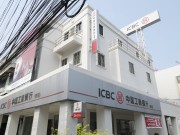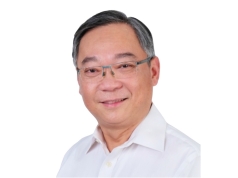Franklin Templeton Investment Strategist Christy Tan: Repercussions of Banking Stress on the Asia-Pacific Region
March 2023 – This is an expert commentary on the impact of bankruptcy of Silicon Valley Bank (SVB), investment flow & liquidity – Repercussions of banking stress on the Asia-Pacific region by Christy Tan, who is the Investment Strategist at Franklin Templeton Institute. Franklin Templeton (Franklin Resources) is one of the largest asset manager in the world with around $1.4 trillion AUM (Assets under Management).
 Franklin Templeton – Franklin Resources, Inc. is a global investment management organization with subsidiaries operating as Franklin Templeton and serving clients in over 155 countries. Franklin Templeton’s mission is to help clients achieve better outcomes through investment management expertise, wealth management and technology solutions. Through its specialist investment managers, the company offers boutique specialization on a global scale, bringing extensive capabilities in equity, fixed income, multi-asset solutions and alternatives. With offices in more than 30 countries and approximately 1,300 investment professionals, the California-based company has 75 years of investment experience and approximately $1.4 trillion in assets under management as of January 31, 2023.
Franklin Templeton – Franklin Resources, Inc. is a global investment management organization with subsidiaries operating as Franklin Templeton and serving clients in over 155 countries. Franklin Templeton’s mission is to help clients achieve better outcomes through investment management expertise, wealth management and technology solutions. Through its specialist investment managers, the company offers boutique specialization on a global scale, bringing extensive capabilities in equity, fixed income, multi-asset solutions and alternatives. With offices in more than 30 countries and approximately 1,300 investment professionals, the California-based company has 75 years of investment experience and approximately $1.4 trillion in assets under management as of January 31, 2023.
Under the Macroscope: Repercussions of banking stress on the Asia-Pacific region

Christy: In the week since the Silicon Valley Bank (SVB) bankruptcy, global authorities have stepped in starting with the Federal Deposit Insurance Corporation (FDIC), the Swiss National Bank (SNB), the People’s Bank of China (PBoC), and the US Federal Reserve (Fed), offering lifelines of liquidity. This will temporarily provide a lid on funding costs so that assets can be unwound with lesser damage to the banking sector balance sheets and loan books can be extended.
The tale of the $100 bill
Christy: This is a reminder of the tale of the $100 bill. The tale is about a town where everyone is in debt and lives on credit. Then a traveler visits the town and hands the motel owner a $100 bill. By the time the visitor leaves, the whole town is debt-free, as the same $100 bill is used by each recipient to pay off those to whom they owe money.* The $100 bill acted as a clearing mechanism, but it did not really address the problem.
*A traveler arrives in a small town and stops at the motel and lays a $100 bill on the desk saying he wants to inspect the rooms. As soon as the man walks upstairs to inspect the rooms, the owner grabs the bill and runs next door to pay the butcher. The butcher takes the $100 and retires his debt to the pig farmer. The pig farmer takes the $100 to pay his bill at the feed store. The feed store owner pays his $100 debt to the motel owner. The motel proprietor now places the $100 back on the counter just as the traveler comes down the stairs, picks up the $100 bill and leaves. No one produced anything and no one earned anything. However, the whole town is debt free.
In United States

Christy: The United States is focused on ring-fencing liquidity and funding issues, while Asia is throwing support to its banks. US-dollar funding is increasingly a global concern and restoring investor confidence may require a global effort. US banks are showing signs of liquidity strains that prompted a record US$164.8 billion in emergency borrowing from the Fed’s discount window. The “dash for cash” also appeared in the Federal Home Loan Banks (FHLBs) system as well as significant rise in repo agreements and forward rate agreements. A “flight to safety” saw bank deposits being withdrawn and rotated into money market funds. FHLBs raised almost US$90 billion in floating-rate notes, on top of other significant funding of about US$260 billion through term discount notes and overnight instruments.
” A “flight to safety” saw bank deposits being withdrawn and rotated into money market funds “
In Asia

Christy: In Asia, the PBoC unexpectedly cut the reserve requirement ratio (RRR) by 0.25%, barely a week after the SVB collapse and Credit Suisse troubles. Policy tightening may be put on the back-burner for now, and some central banks in Asia may start to ease monetary policy earlier than initially planned.
Asian regulators must hold the bottom line of financial stability. The SVB turmoil was a by-product of the Fed’s aggressive rate hikes. Inflationary pressures in Asia may be relatively contained. However, the onus to bring monetary policy from a tight to a neutral state and hold it there for as long as possible is more pertinent than ever.
A deeper look at the US-dollar funding landscape in Asia. Asian central banks will have to manage currency volatility, as bouts of US dollar strength in the near term could lead to further dislocations because of a reduction in the repayment capacity of unhedged borrowers outside the United States. This may further limit their access to the US dollar, increasing the demand for synthetic US-dollar funding, and escalating risk aversion. Funding risks in US dollars or other foreign currencies warrant special attention as central banks cannot create foreign currencies, and the currency regimen or the size of their foreign reserves may constrain their ability to meet banks’ demand for US dollars.
There are more US-dollar liabilities outside the United States than within the country itself. The middle- and low-income countries saw external debt (mostly in US dollars) rise from US$6.39 trillion in 2015 to US$9.3 trillion in 2021 (Note 1). The complex link between Asia’s borrowers and creditors, with banks as intermediaries, could trigger portfolio outflows when the flow of funds is interrupted.
” complex link between Asia’s borrowers and creditors, with banks as intermediaries, could trigger portfolio outflows when the flow of funds is interrupted “
Investment Flow, Liquidity

Christy: The flow of investment to non-US economies involves a chain of transactions that passes from ultimate savers to non-bank financial institutions (NBFIs) and banks, then other intermediaries, before the ultimate non-US borrowers receive the funds. These intermediation chains are now long and complex, across borders and different markets. The intermediation chain is only as resilient as its most vulnerable link.
The greater role of debt markets and NBFIs in funding emerging markets and Asia, along with the chains of intermediation involved in supplying this funding, has made US-dollar liquidity more central as a shock absorber. The chain of events in recent years—including the COVID-19 pandemic, the Russia-Ukraine war, and now US-banking sector stresses—has resulted in shifts in both the demand and supply of liquidity. The demand for liquidity has grown as the size of debt markets and the importance of investment funds offering liquidity- on-demand has increased. The problem is, the supply of market liquidity from banks alone, will not be able to keep pace with this increase. New providers of liquidity may fill some gap, but they have not been stress tested sufficiently.
” The problem is, the supply of market liquidity from banks alone, will not be able to keep pace with this increase “
Asian Fixed Income

Christy: Strength in Asian banking sector and opportunities in Asian fixed income. Asian central banks may be more inclined to implement accommodative and growth supportive policies to cushion the liquidity stresses, creating a more constructive environment for Asian fixed income. Most banks in Asia have been maintaining strong capital buffers and managing prudent leverage post-Russia-Ukraine war and as the Fed embarked on a monetary policy tightening path. Furthermore, the monetary easing moves during the COVID-19 pandemic allowed lenders to strengthen their capital buffers and reduce risk exposures. Banks in the Asia-Pacific region (APAC) are well capitalized and most large APAC banks posted year- over-year improvements in their Basel III leverage ratios (Note 2) in the second quarter of 2022, with mainland Chinese banks leading the pack.
” Strength in Asian banking sector and opportunities in Asian fixed income “
Japanese banks’ exposure to US Treasuries may be sizeable but manageable. Concerns over Japanese financial institutions’ exposure to long-term foreign bonds in a rising-rate environment may be misplaced. Japanese banks and financial institutions differentiate themselves with ample capital and liquidity (Note 3) as well as diverse funding profiles without outsized concentration in a single industry or segment. Furthermore, Japanese officials from Bank of Japan (BoJ), Ministry of Finance (MoF) and its financial watchdog affirmed a coordinated front in readiness to respond to any shocks.
Moral of the $100 bill tale
Christy: All said, even though there’s the assurance of “rich visitors with many $100 bills,” an active investment approach will be important to ride out the volatilities in the near term and to identify securities from resilient issuers with favorable metrics and attractive valuations.
Notes
- Source: World Bank. Middle- and low- income are based on World Bank definition referring to countries with Gross National Income (GNI) below US$13,205 as of July 2022.
- Based on IMF data, Japanese banks’ Tier 1 capital to risk weighted assets ratio is 13.8%, above Basel III accord requirement of 6%. Japanese banks’ interest margin to gross income is 69%, one of
the strongest in Asia. Data as of 2022. - The framework is designed to capture leverage associated with both on- and off-balance sheet exposures, to serve as a backstop to the risk-based capital requirements. Banks are required to hold a leverage ratio in excess of 3%.
This is an expert commentary on the impact of bankruptcy of Silicon Valley Bank (SVB), investment flow & liquidity – Repercussions of banking stress on the Asia-Pacific region by Christy Tan, who is the Investment Strategist at Franklin Templeton Institute.
WHAT ARE THE RISKS?
All investments involve risks, including possible loss of principal. The value of investments can go down as well as up, and investors may not get back the full amount invested. Bond prices generally move in the opposite direction of interest rates. Thus, as prices of bonds in an investment portfolio adjust to a rise in interest rates, the value of the portfolio may decline. Stock prices fluctuate, sometimes rapidly and dramatically, due to factors affecting individual companies, particular industries or sectors, or general market conditions.
Investments in foreign securities involve special risks including currency fluctuations, economic instability and political developments. Investments in emerging markets, of which frontier markets are a subset, involve heightened risks related to the same factors, in addition to those associated with these markets’ smaller size, lesser liquidity and lack of established legal, political, business and social frameworks to support securities markets. To the extent a strategy focuses on particular countries, regions, industries, sectors or types of investment from time to time, it may be subject to greater risks of adverse developments in such areas of focus than a strategy that invests in a wider variety of countries, regions, industries, sectors or investments.
IMPORTANT LEGAL INFORMATION
This material is intended to be of general interest only and should not be construed as individual investment advice or a recommendation or solicitation to buy, sell or hold any security or to adopt any investment strategy. It does not constitute legal or tax advice. This material may not be reproduced, distributed or published without prior written permission from Franklin Templeton. The views expressed are those of the investment manager and the comments, opinions and analyses are rendered as of the publication date and may change without notice. The underlying assumptions and these views are subject to change based on market and other conditions and may differ from other portfolio managers or of the firm as a whole. The information provided in this material is not intended as a complete analysis of every material fact regarding any country, region or market. There is no assurance that any prediction, projection or forecast on the economy, stock market, bond market or the economic trends of the markets will be realized. The value of investments and the income from them can go down as well as up and you may not get back the full amount that you invested. Past performance is not necessarily indicative nor a guarantee of future performance. All investments involve risks, including possible loss of principal. Any research and analysis contained in this material has been procured by Franklin Templeton for its own purposes and may be acted upon in that connection and, as such, is provided to you incidentally. Data from third party sources may have been used in the preparation of this material and Franklin Templeton (“FT”) has not independently verified, validated or audited such data. Although information has been obtained from sources that Franklin Templeton believes to be reliable, no guarantee can be given as to its accuracy and such information may be incomplete. or condensed and may be subject to change at any time without notice. The mention of any individual securities should neither constitute nor be construed as a recommendation to purchase, hold or sell any securities, and the information provided regarding such individual securities (if any) is not a sufficient basis upon which to make an investment decision. FT accepts no liability whatsoever for any loss arising from use of this information and reliance upon the comments, opinions and analyses in the material is at the sole discretion of the user. Products, services and information may not be available in all jurisdictions and are offered outside the U.S. by other FT affiliates and/or their distributors as local laws and regulation permits. Please consult your own financial professional or Franklin Templeton institutional contact for further information on availability of products and services in your jurisdiction.
About Franklin Templeton
 Franklin Resources, Inc. [NYSE:BEN] is a global investment management organization with subsidiaries operating as Franklin Templeton and serving clients in over 155 countries. Franklin Templeton’s mission is to help clients achieve better outcomes through investment management expertise, wealth management and technology solutions. Through its specialist investment managers, the company offers boutique specialization on a global scale, bringing extensive capabilities in equity, fixed income, multi-asset solutions and alternatives. With offices in more than 30 countries and approximately 1,300 investment professionals, the California-based company has 75 years of investment experience and approximately US$1.4 trillion in assets under management as of January 31, 2023. For more information, please visit www.franklintempleton.com.sg
Franklin Resources, Inc. [NYSE:BEN] is a global investment management organization with subsidiaries operating as Franklin Templeton and serving clients in over 155 countries. Franklin Templeton’s mission is to help clients achieve better outcomes through investment management expertise, wealth management and technology solutions. Through its specialist investment managers, the company offers boutique specialization on a global scale, bringing extensive capabilities in equity, fixed income, multi-asset solutions and alternatives. With offices in more than 30 countries and approximately 1,300 investment professionals, the California-based company has 75 years of investment experience and approximately US$1.4 trillion in assets under management as of January 31, 2023. For more information, please visit www.franklintempleton.com.sg
Sign Up / Register
Caproasia Users
- Manage $20 million to $3 billion of assets
- Invest $3 million to $300 million
- Advise institutions, billionaires, UHNWs & HNWs
Caproasia Platforms | 11,000 Investors & Advisors
- Caproasia.com
- Caproasia Access
- Caproasia Events
- The Financial Centre | Find Services
- Membership
- Family Office Circle
- Professional Investor Circle
- Investor Relations Network
Monthly Roundtable & Networking
Family Office Programs
The 2025 Investment Day
- March - Hong Kong
- March - Singapore
- July - Hong Kong
- July - Singapore
- Sept- Hong Kong
- Sept - Singapore
- Oct- Hong Kong
- Nov - Singapore
- Visit: The Investment Day | Register: Click here
Caproasia Summits
- The Institutional Investor Summit
- The Investment / Alternatives Summit
- The Private Wealth Summit
- The Family Office Summit
- The CEO & Entrepreneur Summit
- The Capital Markets Summit
- The ESG / Sustainable Investment Summit


































